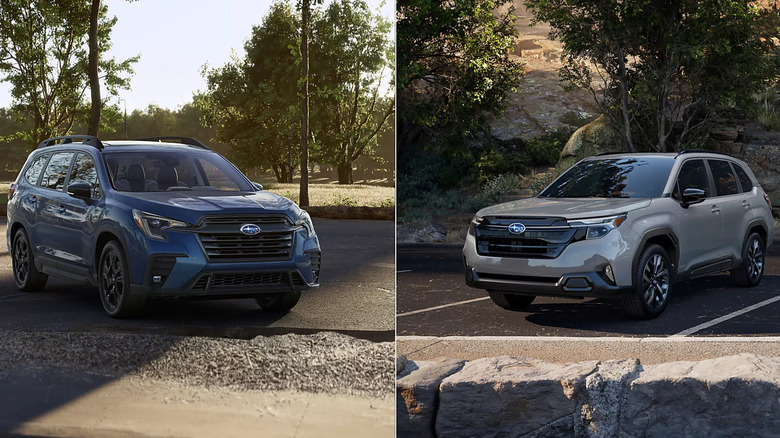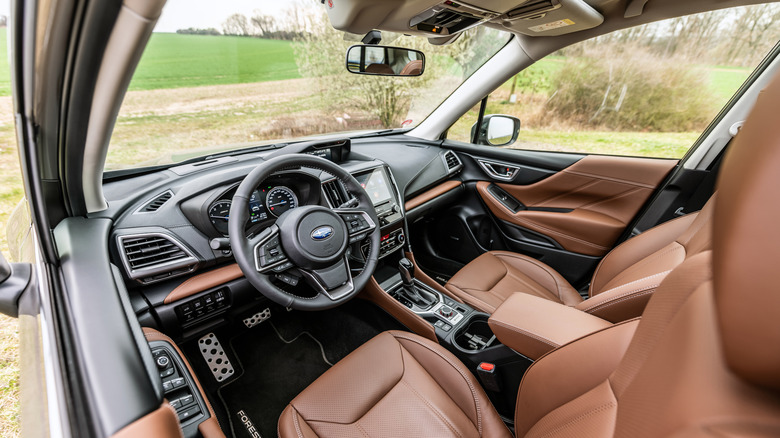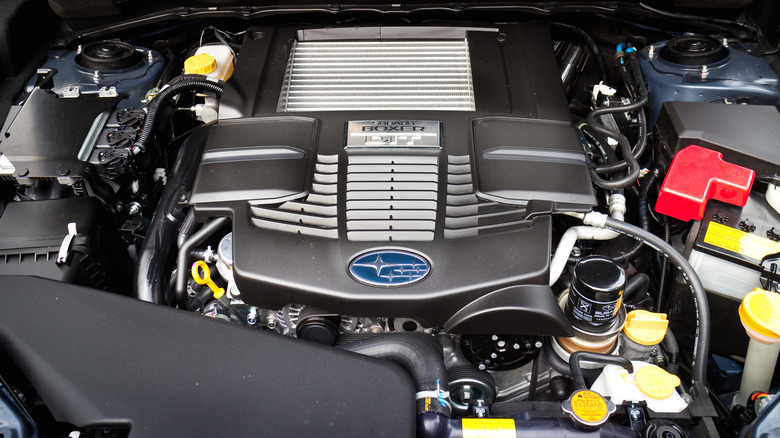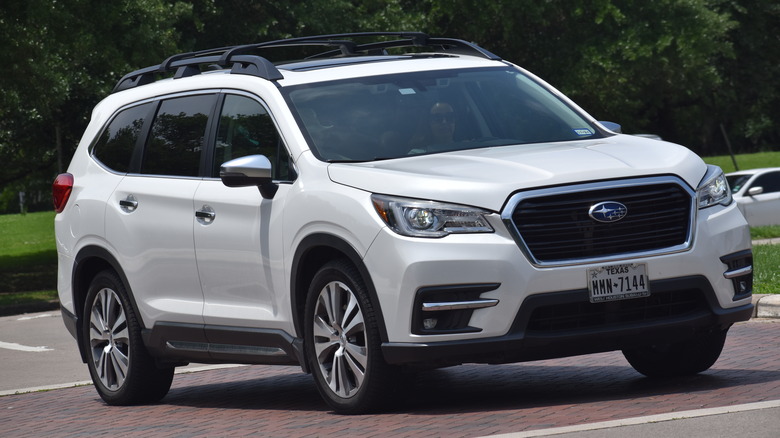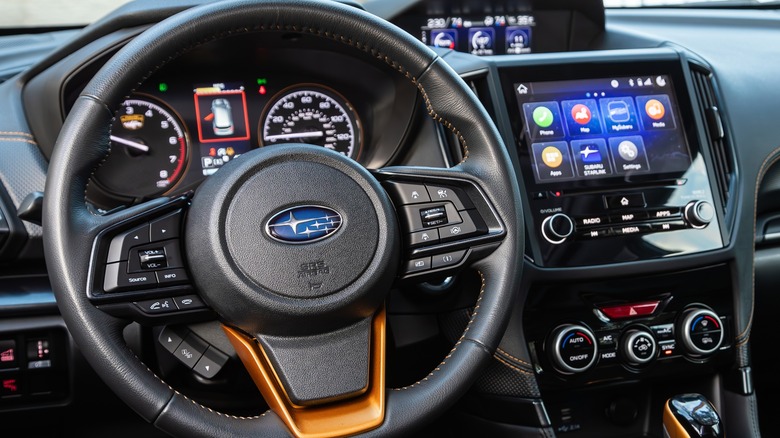What's The Difference Between The Subaru Forester Vs. Ascent?
Subaru has a nice lineup of five SUVs on its roster, many of which are made in the U.S., that anyone would be happy to drive. The automaker has built some reliable vehicles, including the Forester and Ascent. Any Subaru faithful looking to pick up a new SUV might be considering the Forester or the Ascent. Where the Forester has had some good and bad years, the Ascent debuted in 2019 and practically still has that new car smell, making it an appealing buy. If you can't decide between the two, here are some comparisons you might find important.
The Ascent and Forester have many similar features, such as Apple CarPlay and Android Auto integration. However, for as many similarities as they share, they're both very different vehicles meant for two different people. One is better suited for larger families who enjoy hauling their own camper for vacation, while the other is good for cross-country road trips and smaller families.
As the specs for a 2025 Ascent haven't been revealed just yet — an SUV expected to be on the market in fall of 2024 — this article compares the 2024 Ascent to the 2025 Forester, as well as the 2024 Forester Wilderness edition. Subaru extended the Wilderness' availability after the 2025 model went on sale.
Size and interior space
The first thing that stands out between the two SUVs is their size. Looking inside the cabin, drivers will instantly see that the Subaru Ascent seats more passengers, which is crucial for big families. Depending on the trim, the Ascent can have anywhere between 150.2 cubic feet to 153.2 cubic feet of space for passengers. Most versions of the Ascent come with two captain's chairs in the middle row, allowing families to fill it up with seven individuals. However, if they get a trim with bench seating, they can squeeze an eighth person into the cabin. When it comes to cargo space, owners have 75.6 cubic feet to work with.
The 2025 Forester isn't as accommodating with passengers, as it can fit no more than five people in its (at most) 110.8 cubic feet, depending on the trim. Its cargo space isn't too different from the Ascent with 74.4 cubic feet. Looking at exterior dimensions, the Forester comes in at a length of 183.3 inches and a width of 72.2 inches. The Ascent, on the other hand, is 196.8 inches long and an even 76 inches wide. It might only be a little more than a foot longer, but that foot makes a significant difference.
If you're looking for a difference in ground clearance, both SUVs sit 8.7 inches above the road unless you opt for the 2024 Forester Wilderness model, which clears the ground by 9.2 inches.
The engines and their towing capacity
When you have a beefier SUV in size, it's only natural that it gets the beefier engine. The 2024 Subaru Ascent comes with a 2.4-liter turbocharged Subaru BOXER engine capable of producing 260 horsepower. The 2025 Forester, on the other hand, has a 2.5-liter Subaru BOXER engine under the hood, which pushes out 180 horsepower. If an owner has the 2024 Wilderness version of the Forester, it's only slightly more powerful than its 2025 sibling — producing 182 horsepower. When it comes to each vehicle's towing capacity, they're each capable of drastically different purposes.
The Ascent's base trim, being the "weakest" of the other trims, can still pull more than every version of the 2025 Forester, towing up to 2,000 pounds. The other, more expensive versions of the Ascent can each pull as much as 5,000 pounds, letting drivers haul a pop-up camper or travel trailer if need be. The Forester doesn't come close with its 1,500 towing capacity. However, the 2024 Wilderness Forester version finds itself in the middle of the road with the ability to haul up to 3,000 pounds.
Fuel economy and MSRP
In this day and age, with gas prices gradually creeping higher and higher, many consumers pay close attention to a vehicle's fuel economy. It's what leads many to switch over to a hybrid or electric vehicle. As one might expect, the smaller of the two SUVs gets better gas mileage. The Forester's Base, Premium, and Sport trim each get 33 miles to the gallon on the highway, and 26 mpg on streets. The split for the upper two trims, the Limited and Touring, is 32/25 mpg. All of which are better than the estimated 28 and 25 mpg on the 2024 Wilderness model.
The larger Ascent trails the Forester's specs with its lower three trims (Base, Premium 8-Passenger, and Premium 7-Passenger) getting 26 miles to the gallon on the highway, and only 20 mpg on streets. It's Onyx, Limited, and Touring versions do only slightly worse with 25 mpg on highway and 19 mpg on streets. While one could argue that its 19.3 gallon tank — versus the Forester's 16.6 gallon tank — is appealing, it does also mean a larger bill at the gas station. Of course, the miles-per-gallon listed for any car is just an estimate, as a number of factors could change the actual mileage.
Of course, the million dollar question: What does each SUV cost? The Subaru Ascent can cost anywhere between about $35K to roughly $48K. The Forester will run buyers anywhere between roughly $30K and $40K, depending on trim, features, and even paint.
Different interior features
A lot of potential buyers may like to know which SUV has the larger or better touchscreen. The Subaru Ascent, no matter which version, comes with an 11.6 inch touchscreen, whereas the Forester infotainment comes in a variety of sizes. Base model Foresters have a seven-inch screen, while the Wilderness version comes with an eight-inch touchscreen. Premium, Sport, Limited, and Touring trims get the 11.6-inch touchscreen.
Fans of cloth upholstery will to have to go with the Forester's Base or Premium trim, or the Ascent's Base trim. The Ascent, however, comes with two cloth options — one being regular cloth, and the other being a stain-resistant cloth that's available with the Premium model. Both the Forester's and Ascent's Limited and Touring versions come with upholstery trimmed with leather. Furthermore, keyless access and a push-start ignition come standard on most models of both vehicles. The Ascent's Base model doesn't have that, but it's optional on the eight-seat Premium trim. Similarly with the Forester, it's only available beyond the Base model.
Both vehicles in all trims come with Subaru's "Lineartronic" Continuously Variable Transmission (CVT). Other than the Forester's bottom two trims, it includes a manual mode with paddle shifters to switch between eight different gears. SlashGear's Stephen Edelstein drove the new 2025 Subaru Forester and said, "The spread of possible ratios is now wider as well, but neither of these things help acceleration, which is as uninspiring as it was in the old car."
